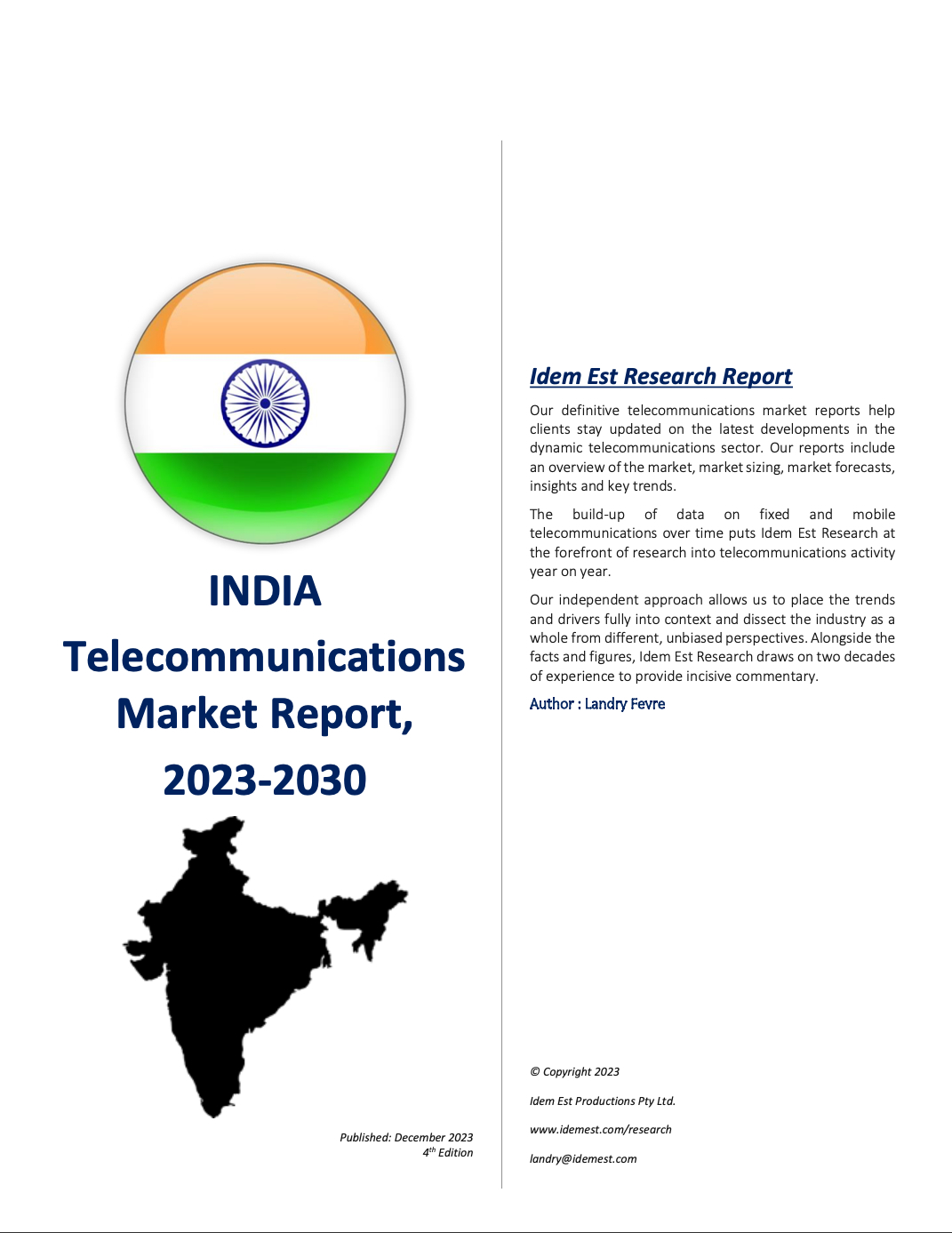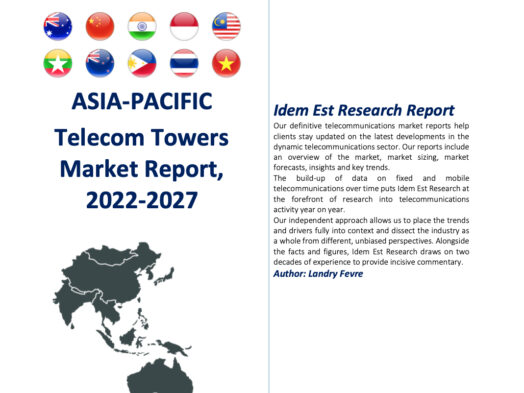Description
WHY YOU SHOULD BUY THE INDIA TELECOMS INDUSTRY REPORT:
- Benefit from the latest market opportunities
- Understand the threats to your operations and investments and protect your company against future risks
- Gain insights on emerging trends supporting, enhancing or disrupting your activities in the market
- Get a full view of the competitive landscape to assess your market position.
- Forecasts as a key input for successful budgeting and strategic business planning in the telecoms market
- Target business opportunities and risks in the telecoms sector through our reviews of latest industry trends, regulatory changes and major deals, projects and investments
- Assess the activities, strategy and market position of your competitors, partners and clients via our Operators Profiles
The India Telecommunications Industry Report, 2023-2030 includes a comprehensive review of the Indian market dynamics, market sizing, market forecasts, analysis, insights and key trends.
EXECUTIVE SUMMARY
India Telecoms Industry Report at a Glance
Globally, the telecommunications sector is proving to be a core and essential infrastructure service to national economies, with data infrastructure becoming critical in a connected world and will likely increasingly attract a new class of investors such as large infrastructure funds. Idem Est Research expects the Indian telecommunications industry to remain steady thanks to the defensiveness nature of the industry, amid the political uncertainties and an uncertain economic outlook due to geopolitics and rising inflation.
Growing mobile phone penetration and emerging fixed broadband take-up among households will fuel future growth over the next five years.
According to our India Telecoms Report, Idem Est Research forecasts that mobile subscriptions and fixed broadband subscribers will continue to fuel the telecoms sector growth in the 2023-30 period. More than 700m people became Internet users over the last six years and another 200m more Internet users are expected to come online over the next six years by 2030.
Market Dynamics and Technological Evolution
The introduction of 4G technology marked a turning point for the Indian telecom market, driving a shift from voice-centric to data-centric services. Mobile data has become integral to digital initiatives and e-governance, underpinning the sector’s growth. However, more needs to be done to increase 4G coverage to the all Indian population with an estimated 1m more mobile towers to cover most of India’s population.
Government initiatives such as ‘Digital India’ aim to create a digitally empowered society, pushing for broader digital payment platforms and broadband accessibility. However, the sector faces challenges like high competition, regulatory uncertainties, and infrastructure issues, particularly in rural areas. Financial stress, highlighted by high debt levels and the complexity of Adjusted Gross Revenue (AGR), adds to these challenges.
The telecommunications industry in India is at a critical juncture, requiring supportive policies, regulatory stability, and continuous investment to overcome these challenges and harness its full potential.
Market Composition and Revenue Trends
The market comprises three major operators with mobile and fixed networks – Bharti Airtel, Reliance Jio, and Vodafone Idea – alongside two state-owned operators and several smaller fixed network operators. The reported market revenue grew from INR 2.6 trillion in 2016 to INR 3.2 trillion in 2022. This growth is attributed mainly to mobile service and fixed broadband revenue expansion. Despite the earlier decline in legacy voice and SMS revenues, market growth is expected to continue steadily towards 2030.
Capital Expenditure and Investment Trends
Capital expenditure (Capex) in the sector has seen dynamic shifts over the years. The overall market Capex decreased from INR 1006 billion in 2016 to INR 970 billion in 2022. Operators like Jio have heavily invested in building out their networks, while others like Vodafone Idea have focused on merger synergies and the elimination of redundant infrastructure. Bharti Airtel, in response to Jio’s aggressive market entry, increased its Capex in 2022 to accelerate its 5G rollout.
Future Prospects and Growth Forecast
Idem Est Research forecasts that mobile subscriptions will grow at an annual average rate of 2% from 2023 to 2030, and fixed broadband subscribers at an average rate of 12.6% over the same period. With nearly 700 million Indian people becoming Internet users in the last six years, and an additional 200 million expected by 2030, the sector is poised for substantial growth. This growth, however, needs to be supported by innovative strategies to enhance industry revenues and profitability while managing the extensive debt burden.
Conclusion
The Indian telecommunications sector stands as a key driver of the country’s socio-economic development. With its vast potential for growth, the industry’s success hinges on its ability to adapt to technological changes, manage financial health, and meet the burgeoning data needs of one of the world’s largest internet user bases. A balanced approach to growth, innovation, and regulatory frameworks will be crucial in shaping the future of telecommunications in India.
According to our benchmark study of mobile data pricing, India has the lowest rate per GB at just a few cents per GB, while Australia and China had the biggest cost reduction per GB mostly due to increased data allowance in plans while Singapore remains expensive.
Broadband Subscribers – FTTH Push and Fixed Wireless
The fixed broadband market is experiencing strong growth mostly driven by the loss of share by the incumbent BSNL, followed by Bharti Airtel, Atria Convergence Technologies (ATC), Reliance Jio, ONEOTT, Excitel, GPTL and Vodafone Idea via its subsidiary You Broadband, all are now investing in full-fibre networks.
However, more competition is expected in the fixed broadband market with Jio’s entry with its residential fibre broadband services disrupting incumbent BSNL but increasing the residential broadband subscriptions significantly.
Fixed broadband penetration is forecasted to grow strongly as India’s investments on full-fibre networks are starting to pay off with affordable packages and increased broadband household penetration growing.
Thematics – Telecoms Infrastructure / 5G / M&A / Infrastructure
Infrastructure funds, pension funds and government funds are assigning high valuation multiples to telecommunications infrastructure assets such as mobile towers, data centres, submarine cable and fibre infrastructure.
Investment funds are assigning high valuation multiples to telecommunications infrastructure assets such as mobile towers, data centres, submarine cable and fibre infrastructure. This report outlines some real market examples of how investors view and value these investments with real industry examples and EV/EBITDA comparatives and benchmarks.
Our India Telecoms Industry Report transactions database analysis highlights the hive of transactions in the India tower market, with the majority of telecommunications operators shifting assets to infrastructure entities and selling down to repay debts and further investments for capacity and coverage of their mobile networks. However, in the short to medium term, the telco sector is likely to experience some corporate activity with the fixed broadband market, now expected to come under pressure with JioFiber’s launch and also broaden the scope of services beyond carriage to content and e-Commerce. Idem Est Research projects strong earnings growth despite the huge debt pile and the looming required 5G and fibre to the home investments by the telecommunications operators. A new wave of M&A, network sharing deals over the next two to three 3 years will continue to consolidate around the large mobile operators, Bharti Airtel, Vodafone Idea and Reliance Jio.
The arrival of 4G moved the Internet off our desktops into our palms and pockets, 5G could transform the network from something we carry around to something taking us around either virtually (augmented reality or virtual reality) or in reality (autonomous vehicles), the 5G outcome and benefits beyond fast connectivity remain largely unknown in terms of business models, investments required and timeline.
KEY COMPANIES MENTIONED IN THIS INDIA TELECOMS INDUSTRY REPORT:
Alliance Broadband, American Tower Corporation (ATC), Asianet Satellite, Atria Convergence Technologies (ACT), Bharti Airtel, Bharat Sanchar Nigam Limited (BSNL), Eutelsat OneWeb, Excitel, GPTL, GTL Infrastructure, Hathway Cable, Intech Online, Kerala Vision, Mahanagar Telephone Nigam Limited (MTNL), Netplus, ONOTT, Quadrant, RaiTtel, Reliance Communications (RCom), Reliance Jio, Sify, Starlink, Tata Communications, Tata Play Broadband, Tikona, Vodafone Idea
India Telecoms Industry Report – Table of Contents
Table of Contents
1 Key Statistics
1.1 India Population
1.2 India’s Economy
1.3 India’s GDP
2 Overall Telecommunications Market, 2016–2030
2.1 Market Overview
2.2 Historical Telecommunications Market Revenue, 2016-2022
2.3 Overall Telecommunications Market Forecast, 2022-2030
2.4 Telecommunications Market Capital Expenditure, 2016-2030
2.4.1 Historical Telecommunications Capex Spend, 2016-2022
2.4.2 Capex to Revenue Country Benchmark
2.4.3 Capex to GDP Benchmark
2.4.4 Telecommunications Capex Spend Forecast, 2022-2030
3 India Telecommunications Operators Profile
3.1 Bharti Airtel Profile
3.1.1 Bharti Airtel Revenue, EBITDA and Capex Mix, 2016-2022
3.2 Vodafone Idea Profile
3.2.1 Vodafone Idea Revenue, EBITDA and Capex Mix, 2016-2022
3.3 Reliance Jio Profile
3.3.1 Jio Corporation Revenue, EBITDA and Capex Mix, 2016-2022
3.4 BSNL Profile
3.4.1 BSNL & MTNL Revenue and Capex, 2016 – 2022
3.5 Other Players Profile
3.5.1 Tata communications
3.5.2 Global International Carriers
3.5.3 Other Telecom Operators
4 India Mobile Market
4.1 Mobile Subscribers Historical and Forecast, 2016-2030
4.1.1 Mobile Subscribers Historical, 2016-2023
4.1.2 Mobile Subscribers Market Share, 2016-2023
4.1.3 India Smartphone Share, 2022
4.1.4 India Mobile Subscribers Forecast, 2022-2030
4.1.5 India Mobile Subscribers by Generation (2G, 3G, 4G & 5G) Forecast, 2022-2030
4.2 Mobile Revenue Historical and Forecast, 2016-2030
4.2.1 Historical India Mobile Service Revenue, 2016-2022
4.2.2 Mobile Service Revenue Forecast, 2022–2030
4.2.3 Mobile Subscribers ARPU, 2016-2022
4.3 Spectrum Holdings
4.3.1 Spectrum Pricing and Regulation
4.3.2 5G Trials and 5G Auctions Results
4.3.3 Mobile Frequencies Portfolios Analysis
4.3.1 Spectrum Depth Benchmark by Country
4.4 Mobile Download Data and Pricing Trends
4.5 Mobile Speed Tests
4.6 Internet of Things (IoT)
5 India Broadband Market
5.1 Fixed Broadband Subscribers Historical, 2016-2023
5.2 Fixed Broadband Subscribers Forecast, 2022-2030
6 Satellite Internet Connectivity
6.1 Comparing LEO, MEO, and GEO Satellite Orbits
6.1.1 LEO and GEO Satellite Comparison
6.2 Satellite Broadband Providers Operators, 2023
6.3 5G NTN: The Next Generation of Satellite Connectivity
6.3.1 5G NTN Overview
6.3.2 The Rationale Behind 5G NTN
6.3.3 Technical Aspects of 5G NTN
6.3.4 Potential Applications for 5G NTN
6.3.5 Challenges in Implementation
6.3.6 5G NTN Satellite Providers
6.4 Satellite Internet Market Analysis, 2022-2030
6.4.1 Market Landscape of Satellite Broadband Subscribers, 2022
6.5 India Satellite Broadband Subscribers Forecast, 2022-2030
7 India Telecommunications Infrastructure Investments
7.1 Fixed Digital Infrastructure
7.1.1 Government Plans
7.1.2 Submarine Cables
8 India Telecom Towers Infrastructure Landscape
8.1 India Telecom Towers Market Analysis, 2022
8.1.1 India Telecom Towers Market Overview
8.1.2 India Telecom Towers Background
8.2 India Tower Market Competitive Landscape Comparison
8.3 India Telecom Towers & Rooftops Market Forecast
8.3.1 India Telecom Towers and Rooftops Forecast, 2022-2030
8.4 Indus Towers Profile
8.4.1 Indus Towers Revenue, EBITDA and Capex, 2016 – 2022
8.5 Data Infrastructure Trust Profile
8.5.1 Data Infrastructure Trust Towers Key Performance Indicators
8.6 American Tower Profile
8.6.1 American Tower Key Performance Indicators
8.7 GTL Infrastructure Profile
8.7.1 GTL Infrastructure Towers Key Performance Indicators
8.8 Ascend Telecom Profile
8.8.1 Ascend Telecom Towers Key Performance Indicators
8.8.2 Tower Vision Profile
8.8.3 Tower Vision Towers Key Performance Indicators
8.9 Spectrum Holdings
8.9.1 Spectrum Regulation
8.9.2 Regulatory Considerations
8.10 Telco Infrastructure Comparative
9 Thematics / Opportunities
9.1 Consolidation Opportunities
9.2 Diversification Opportunities
9.2.1 e-Commerce
9.2.2 Digital Payments
9.3 New Telecoms Operating Model
9.3.1 The Attraction of Infrastructure Multiples
9.4 6G Developments
10 Telco M&A Transaction Database
11 Methodology
12 Copyright Notice
India Telecoms Industry Report – List of Figures
Figure 1 – Telco sector revenue as % of GDP in India
Figure 2 – Gross Revenue Profile Historical Mix(INR bn), 2016 – 2022
Figure 3 – Telecommunications Market Revenue Pool, 2022
Figure 4 – Telecommunications Market EBITDA Pool, 2022
Figure 5 – Telecommunications Revenue & EBITDA Share Estimates, 2022
Figure 6 – Total Telecoms Market Gross Revenue and Growth Rate (INR bn), 2022-2030
Figure 7 – Capex to Revenue Benchmark, 2016-2022
Figure 8 – Capex to GDP Ratio Benchmark, 2016-2022
Figure 9 – Telecommunications Capital Expenditure Spend, 2000-2030
Figure 10 – Bharti Airtel Service Revenue Mix, 2016-2022
Figure 11 – Bharti Airtel Historical Revenue Mix, 2016 – 2022 (INR m)
Figure 12 – Vodafone Idea Operating Revenue Mix, 2016-2022
Figure 13 – Reliance Jio Historical Revenue, EBITDA and Capex (INR m), 2016 – 2022
Figure 14 – BSNL & MSNL Historical Revenue (INR m), 2016 – 2022
Figure 15 – Tata Communications Revenue and Revenue Growth (INR m), 2016-2022
Figure 16 – Global Carrier Gross Revenue and Growth (INR m), 2016-2022
Figure 17 – ATC Gross Revenue and Growth Rate (INR m), 2016-2022
Figure 18 – Mobile Subscribers Share Comparison, 2016-2023
Figure 19 – Mobile Subscriber Share Comparison, 2016-2023
Figure 20 – Mobile Net Adds (000’s) Comparison, 2016-2023
Figure 21 – Mobile Subscribers Forecast, 2016-2030
Figure 22 – India Mobile Subscribers by Generation (2G, 3G, 4G & 5G) Forecast, 2022-2030
Figure 23 – Mobile Service Revenue Forecast (INR bn), 2022-2030
Figure 24 – Mobile Subscribers ARPU (INR), 2016-2022
Figure 25 – India Telecom Circles Map
Figure 26 – Subscriptions per MHz of Spectrum, Emerging Asia-Pacific Countries, 2022
Figure 27 –Mobile Handsets Monthly Download Data, 2017-2022
Figure 28 – Data Pricing Trends in Asia-Pacific (US$ per GB per month), 2017-2022
Figure 29 – Asia Pacific Data Pricing Benchmark, 2022
Figure 30 – IoT Operators and Spectrum Available for IoT in India
Figure 31 – Broadband Subscribers Share Comparison, 2016-2023
Figure 32 – India Net-Adds (000’s) by Operators, 2016-2023
Figure 33 – Broadband Subscribers Forecast, 2016-2030
Figure 34 – Satellite Deployments Type
Figure 35 –Starlink and OneWeb Satellite Launches per Month (Data until Sep-23)
Figure 36 – Asia Pacific Satellite Broadband Subscribers Forecast, 2022-2030
Figure 37 – India Telecom Towers Market Share, 2022
Figure 38 – India Telecom Towers & Rooftops Forecast, 2022-2030
Figure 39 – Telecoms Providers EV/EBITDA Ranges
India Telecoms Industry Report – List of Tables
Table 1 – India – Key Statistics
Table 2 – Telecommunications Market Gross Revenue by Operators, 2016-2022
Table 3 – Total Telecommunications Market Revenue, 2022-2030
Table 4 – Historical Telecommunications Capex Spend, 2016-2022
Table 5 – Total Telecommunications Capex Investments Forecast, 2022-2030
Table 6 – Historical Bharti Airtel Revenue, EBITDA and Capex, 2016-2022
Table 7 – Historical Vodafone Idea (Pro Forma) Revenue and EBITDA Mix, 2016-2022
Table 8 – Historical Reliance Jio Corporation Revenue and Profit Mix, 2016-2022
Table 9 – Historical BSNL and MTNL Revenue, EBITDA & Capex, 2016-2022
Table 10 – Historical Tata Communications Revenue, 2016-2022
Table 11 – Historical Global Carrier Gross Revenue, 2016-2022
Table 12 – Historical ACT Revenue, 2016-2022
Table 13 – Historical Mobile Subscribers, 2015-2022
Table 14 – India Mobile Subscribers Forecast, 2022-2030
Table 15 – India Mobile Subscribers by Generation (2G, 3G, 4G & 5G) Forecast, 2022-2030
Table 16 – Historical Mobile Service Revenue, 2016-2022
Table 17 – Mobile Service Revenue Forecast, 2022-2030
Table 18 – Historical Mobile Market Blended Mobile ARPU, 2016-2023
Table 19 – Mobile Spectrum by Operators and by Band (MHz)
Table 20 – Bharti Airtel Mobile Frequencies and by Band (MHz)
Table 21 – Vodafone Idea Mobile Frequencies and by Band (MHz)
Table 22 – Reliance Jio Mobile Frequencies and by Band (MHz)
Table 23 – BSNL/MTNL Frequencies and by Band (MHz)
Table 24 – Historical Broadband Subscribers, 2016-2023
Table 25 – Historical Broadband Monthly ARPU, 2016-2023
Table 26 – India Broadband Subscribers Forecast, 2022-2030
Table 27 – Satellite Orbit Altitudes
Table 28 – Satellite Broadband Subscribers Operators, 2023
Table 29 – 5G NTN and Satellite Providers, 2023
Table 30 – Asia Pacific Satellite Broadband Subscribers Forecast, 2022-2030
Table 31 – International Submarine Cable Systems with Landing Stations in India
Table 32 – India Telecom Towers Market Analysis, 2022
Table 33 – India Telecom Towers Indicative Tower Leasing Annual Fees
Table 34 – India Tower Market Competitive Landscape Comparison
Table 35 – India Telecom Towers Transaction Database, 2009-2023
Table 36 – India Telecom Towers and Rooftops, Revenue, Mobile Subscribers, Penetration & ARPU Forecast, 2022-2030
Table 37 – Historical Indus Towers Co Revenue, EBITDA & Capex, 2016-2022
Table 38 – Data Infrastructure Trust Key Performance Indicators, 2022
Table 39 – American Tower Key Performance Indicators, 2022
Table 40 – GTL Infrastructure Towers Key Performance Indicators, 2022
Table 41 – Ascend Telecom Towers Key Performance Indicators, 2022
Table 42 – Tower Vision Towers Key Performance Indicators, 2022
Table 43 – Bharti Airtel, Vodafone Idea, Reliance Jio, BSNL and Tata Communications Infrastructure Landscape
Table 44 – Telco Transaction Database, 2009-2023
Other Idem Est Research Telecoms Country Reports
Australia, Bangladesh, China, India, Indonesia, Japan, New Zealand, Malaysia, Myanmar, Pakistan, Philippines, Singapore, South Korea, Taiwan, Thailand, Vietnam,
Asia Pacific Telecom Towers, Asia Pacific Satellite Internet




